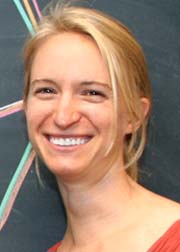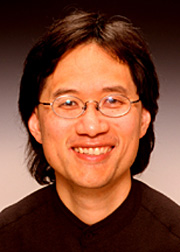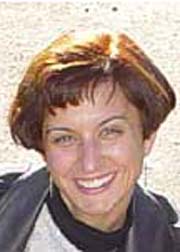Register
Click here to register on-line, and pay by credit card (deadline 5 pm, April 6th).
Click here to register by mail, and pay by check (deadline April 5th).
Spring SoCal-Nev Section Meeting
Harvey Mudd College, (Directions and Map)
Saturday, April 10, 2010
- 8:15-12:00 Registration
Hixon Court, at the entrance of Galileo Hall - 8:15-10:30 Refreshments
Hixon Court, at the entrance of Galileo Hall - 8:30-2:30 MAA Book Sale
Galileo Hall Lobby
Organized by Richard Katz and Michael Hoffman, Cal State Los Angeles - 9:00-10:00 Invited Address by Scott Kim, www.scottkim.com
Teaching Students to Invent Puzzles
McAlister Lecture Hall in Galileo Hall - 10:00-10:15 Section Business Meeting
McAlister Lecture Hall in Galileo Hall
Presentation of Section Distinguished Teaching Award
Recognition of 25- and 50-year members - 10:15-11:15 Student Poster Session
View the Call for posters and apply on-line.
Courtyard above Galileo Hall
Organized by Cynthia Wyels, CSU Channel Islands - 11:15-12:15 Invited Address by Zvezdelina Stankova, Mills College
Exploring pattern avoidance: unsolved questions and baffling answers
McAlister Lecture Hall in Galileo Hall - 12:15-1:30 Luncheon
Location Hoch Shanahan Dining Commons - 1:30-2:30 Invited Address by Alissa Crans, Loyola Marymount Univerity
Musical Actions of Dihedral Groups
McAlister Lecture Hall in Galileo Hall - 2:30-3:00 Refreshments
Galileo Hall Lobby - 3:00-4:00 Invited Address by Ken Ono, University of Wisconsin, Madison
Unearthing the visions of a master: The story and legacy of Ramanujan
McAlister Lecture Hall in Galileo Hall
Directions and Maps
For directions, see the campus website at
www.hmc.edu/campusmap/regional.htm
For a campus map, see the website at
www.hmc.edu/campusmap
Parking
There are parking lots on south side of Foothill Blvd and on the north side of Platt Blvd, just east of Dartmouth Avenue, as well as street parking along Foothill Blvd. See the campus map at www.hmc.edu/campusmap
Hotels
Doubletree Hotel Claremont
555 W. Foothill Blvd.
Claremont, California, USA, 91711
1-909-626-2411
www.doubletree.com
Doubletree Hotel Ontario Airport
(with an airport shuttle service)
22 North Vineyard Avenue
Ontario, California, USA, 91764-4431
1-909-937-0900
www.doubletree.com
Register
Click here to register on-line, and pay by credit card (deadline 5 pm, April 6th).
Click here to register by mail, and pay by check (deadline April 5th).
Registration Fees
| Registration | |
| Nonmember | $35 |
| MAA Member | $30 |
| Student | $12 |
| Registration and Luncheon | |
| Nonmember | $50 |
| MAA Member | $45 |
| Student | $20 |
On-site registration will be available for the meeting, but will be $5 more than the pre-registration charge.
Register on-line
Click here to register on-line, and pay by credit card (deadline 5 pm, April 6th).
Register by mail
Click here to register by mail, and pay by check (deadline April 5rd).
Alissa CransLoyola Marymount University |
Alissa S. Crans earned her B.S. in mathematics from the University of Redlands in 1999 and her Ph.D. in mathematics from the University of California at Riverside in 2004, under the guidance of John Baez. She is currently an Assistant Professor of mathematics at Loyola Marymount University and has held positions at Pomona College, The Ohio State University, and the University of Chicago. Alissa’s research is in the field of higher-dimensional algebra and her current work, funded by an NSA Young Investigator Grant, involves categorifying algebraic structures called quandles with the goal of defining new knot and knotted surface invariants. She is also interested in the connections between mathematics and music, and enjoys playing the clarinet with the Santa Monica College wind ensemble. Alissa is extremely active in helping students increase their appreciation and enthusiasm for mathematics through co-organizing the Pacific Coast Undergraduate Mathematics Conference together with Naiomi Cameron and Kendra Killpatrick, and her mentoring of young women in the Summer Mathematics Program (SMP) at Carleton College, the EDGE program, and the Career Mentoring Workshop. |
Musical Actions of Dihedral Groups
Can we hear an action of a group? Or a centralizer? In the same way it is possible to see group structure in a crystal, it is also possible to hear group structure in music. We will investigate two ways that the dihedral group of order 24 acts on the set of major and minor chords and illustrate both geometrically and algebraically how these two actions are dual. Both actions and their duality have been used to analyze works of music as diverse as that of Beethoven and the Beatles. (This is joint work with Thomas M. Fiore and Ramon Satyendra.)
Scott KimPuzzlemaster |
Scott Kim is an independent game designer who designs original visual thinking puzzles for the web, computer games, magazines and toys. Major projects include puzzles for web sites Adobe.com and Juniornet.com, computer games Obsidian and Escher Interactive, magazines Discover and Games, and physical toy Railroad Rush Hour. His interest in puzzles sprang from an early interest in mathematics, education and art. His first puzzles appeared in Scientific American in Martin Gardner's Mathematical Games column. Other pursuits include creating "inversions" (words that read in more than one way), and creating educational dance performances about mathematics. He was born in 1955, raised in Los Angeles, and attended Stanford University, where he received a BA in music and a self-designed PhD in Computers and Graphic Design. He currently lives in El Granada, California, near San Francisco, with his wife Amy (online community strategist and author of Community Building on the Web) and his son Gabriel. You can read more about his work on his web site www.scottkim.com.
|
Teaching Students to Invent Puzzles
All math students learn to solve problems. But as every mathematician knows, being able to solve problems is only half the battle. To think like a mathematician, students also need to be able to invent their own problems -- to identify interesting areas and ask new questions. Mathematical research thrives on just this ability.
But you don't have to be a research mathematician to invent original problems. In this talk I will talk about work I have done asking students of all ages invent original mathematical problems. I will show how I have used the puzzle toy Rush Hour to teach techniques of puzzle design. I will show how I have built computer games that let players invent puzzles for others to solve. And I will show how puzzle invention can be taught in gradual steps that move a student from simply modifying an existing puzzle to creating something truly original. Finally, I will discuss how designing puzzles is similar to doing original mathematical research.
Ken OnoUniverstiy of Wisconsin,Madison  |
Ken Ono received his PhD from UCLA in 1993, under the guidance of Basil Gordon. Upon graduation, he held positions at the University of Georgia, the University of Illinois Urbana-Champaign, the Institute of Advanced Studies, and Penn State University, where he was named the Louis P. Martarano Professor in 1999. He is presently the Manasse Professor of Letters and Science, and the Hilldale Professor of Mathematics at the University of Wisconsin at Madison. He has authored over 100 research papers, as well as the CBMS monograph entitled The Web of Modularity. His work includes ground-breaking results on partition congruences, modular forms, Borcherds products and mock theta functions. He has advised 17 PhD students to date, and he sits on the editorial boards of 11 journals. He has received awards including a Sloan Fellowship, a Presidential Early Career Award (awarded by President Clinton), a Packard Fellowship, and a Guggenheim Fellowship. In addition to his research accomplishments, Ono is a well known lecturer and teacher, as evidenced by his receipt of the 2005 National Science Foundation Director's Distinguished Teaching Scholar Award, and the 2007 and 2009 Favorite Instructor Award from the University of Wisconsin Residence Halls. |
Unearthing the visions of a master:
The story and legacy of Ramanujan
The legend of Ramanujan is one of the most romantic stories in the modern history of mathematics. It is the story of an untrained mathematician, from south India, who brilliantly discovered tantalizing examples of phenomena well before their time. Indeed, the legacy of Ramanujan's work (as a whole) is well documented and includes direct connections to some of the deepest results in modern number theory such as the proof of the Weil Conjectures and the proof of Fermat's Last Theorem. However, one final problem remained, the enigma of the functions which Ramanujan discovered on his death bed. Here we tell the story of Ramanujan and this final mystery.
Zvezdelina StankovaMills College |
Zvezdelina Stankova (Zvezda) is a Frederick A. Rice Associate Professor of Mathematics at Mills College, where she has served as the Department Head for two years. She is the founder and the Director of the Berkeley Math Circle at UC Berkeley. As a postdoctoral fellow at MSRI and UC Berkeley in 1997-1999, Zvezda came full circle by founding the Berkeley Math Circle (BMC) and co-founding the Bay Area Mathematical Olympiad. Since then, she has delivered more than 200 math circles sessions and conference presentations at over 45 locations. Starting with a handful of math circles in 1998, Zvezda's pioneering work in collaboration with MSRI, AIM and a number of SF Bay Area mathematicians, helped inspire and establish dozens of new circles throughout the U.S. and abroad (the current count is around 75). In addition, she trained the USA national team for the IMOs for six years, including the memorable year 2001 when three of the six U.S.A. team members were from BMC. In 2009, she co-edited "A Decade of the Berkeley Math Circle - the American Experience'', volume I, published by AMS in the MSRI book series Mathematical Circles Library. Her article there on Inversion in the Plane was inspired by one of the very first lectures she heard as a teenager at the training of the Bulgarian IMO team. A second volume is forthcoming. Since 1999, she has worked at Mills College. Her current research interests include classification of restricted patterns, specifically, Wilf-equivalences and shape-Wilf-ordering, in the area of enumerative and algebraic combinatorics. Zvezda's inspiring style and passion to teach and communicate mathematics beyond the classroom have been recognized by the MAA: in 2004 she was selected as a co-recipient of the first Henry L. Alder Award for Distinguished Teaching by a Beginning College or University Mathematics Faculty Member. |
Exploring pattern avoidance: unsolved questions
and baffling answers
According to a classic result of Erdös and Szekeres from 1935, any permutation of large enough length will contain an increasing or a decreasing subsequence of correspondingly large length. Formally said, the identity permutation Ik = (1,2,3,…,k) and its reverse Jk = (k,k-1,…, 2,1) impose too many conditions on permutations of length > (k-1)(l-1) and hence cannot be simultaneously avoided. What if we try to avoid only one permutation at a time? Seemingly simpler, this is the most fundamental and toughest question in the arena of restricted patterns. Classification of patterns according to their restrictiveness (or Wilf-equivalence) has been completed only up to length 8 over the course of several decades. Calculating the exact probability of avoiding a specific pattern still eludes researchers; back in the 80’s, the answer for level 3 was provided by the nth Catalan number; yet, to this day the length-4 patterns have yielded answers only for 1342 and 1234. The 1234-calculation, for example, was done by Gessel in 1990, using D-finite power series and notions removed from the classic flavor of restricted patterns. In this talk, we shall explore the ever-tempting question of Wilf-classification; specifically look for an alternative, combinatorial proof of enumerating the 1234-avoiding permutations; and discuss whether, among the array of generated ideas and methods, there is a "true'' way of approaching pattern-avoidance.
Call for Posters
Undergraduates and Masters students are invited to participate in the Student Poster Contest. Possible topics include:- Results of masters thesis, honors, senior, or independent study projects;
- Results of classroom projects or modeling contests;
- Results of REUs or other summer research programs;
- Historical investigations in pure or applied mathematics;
- Solutions of problems from the Putnam Exam or from the Monthly or other journals.
The deadline for submission is March 29, 2010. To submit, provide title, abstract, and presenter info at http://www.surveymonkey.com/s/9Z5VHFN.
